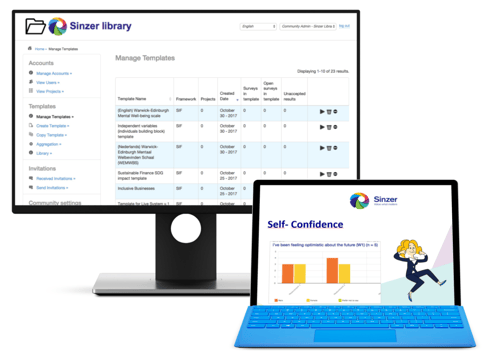Many social entrepreneurs, youth workers, or professionals working in the Third sector, aim to establish an increase in the self-confidence of their participants or clients. An increase in self-confidence can help to diminish anxiety to fail, which in turn can have a positive influence on someone’s quality of life.
Self-confidence can be defined as: ‘the ability to take charge of your own destiny’ or in other words: confidence in who one is and what one can, its powers and abilities.
In order to measure the extent of self-confidence, researchers typically make a distinction between two aspects of the concept: (1) self-esteem and (2) self-efficacy. While self-esteem refers to the regard or respect a person has for oneself, self-efficacy refers to a person’s belief in their ability to accomplish a specific goal or task, for example in relation to his or her profession.
Sinzer Library
For each of these aspects, there is a validated scale. Sinzer advices to work with validated scales, since they are tested whether they indeed measure what you intend to measure.
- The Rosenberg Self Esteem Scale. This scale contains 10 items, with which you either strongly disagree, disagree, agree or strongly agree. The strength of this scale is that positive items, such as: ‘I feel that I have a number of good qualities’ are alternated with negative items, such as: ‘All in all, I am inclined to feel that I am a failure.’ In this way, respondents are not steered toward a certain direction when answering. The level of self-esteem is calculated by adding the values of the answers. A higher score indicates a higher level of self-esteem.
- The General Self-Efficacy Scale. This scale contains 10 items, based on a 4-point scale ranging from 4 Exactly true – 1 Not at all true. Examples of items: ‘I can always manage to solve difficult problems if I try hard enough’ and ‘I can remain calm when facing difficulties because I can rely on my coping abilities’.
The latter items can also be made more specific, for example if your organisation specifically focuses on certain professional or coping skills. Note: these adapted indicators are not validated anymore, but may better apply to your intervention.
Both scales are currently made available in the Sinzer Library: an online database containing some of the most commonly used templates, indicators and scales. This means that you can easily copy these scales or just a set of indicators and use it in your own custom template that you can create in the Sinzer tool.

Do you want to learn more about how to use these of one of our other templates?
Request a free demo of our tool!
-1.jpg?width=232&name=GT%20Sinzer_logo_screen_descriptor%20(1)-1.jpg)

-1.jpg)
